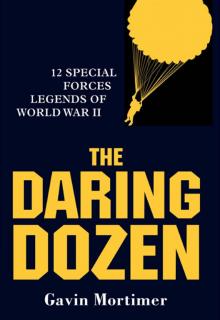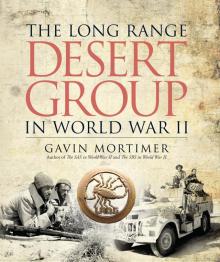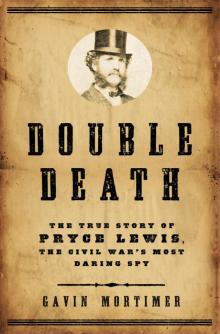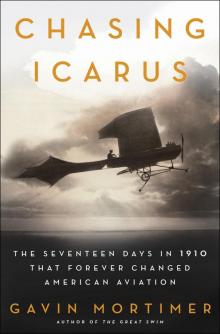- Home
- Gavin Mortimer
The Long Range Desert Group in World War II Page 6
The Long Range Desert Group in World War II Read online
Page 6
But Colonel d’Ornano didn’t. Sitting in the back of Clayton’s vehicle, the Frenchman was killed instantly by a bullet to his throat. The Bofors was brought to bear on the gun emplacement, and it was destroyed. As the LRDG concentrated their fire now on the hangar and the defenders inside, Kennedy Shaw watched in amazement as ‘shuffling with half-bent knees across the landing ground … a string of old women carrying firewood bundles on their heads’.
There was a brief lull in the shooting, long enough for the raiders on the airfield to turn their gaze towards the fort in response to the explosion caused by the mortar shell hitting the central tower. ‘All the time there were snipers,’ recalled Jopling. ‘But we couldn‘t find out where the bullets were coming from.’
For close on two hours the firefight with the Italians inside the hangar continued. Then a white flag was waved from the one of the windows. Clayton sent one of the prisoners taken early on in the raid to parley with the bearer of the flag. Soon around 20 men of the Italian Air Force emerged with their hands in the air. Clayton placed them under guard, and then the LRDG delved inside the hangar. ‘There were three beautiful Gibley bombers costing about £15,000 each,’ wrote Jopling. ‘And a beautiful sending and receiving wireless set and many bombs, parachutes and other valuable equipment. Of course, all the boys were in for a bit of looting and while that was going on, the planes and building were soaked in benzine and the wireless set smashed, and after taking thousands of rounds of .303 ammunition and many rifles we left a trail of benzine and set a match to it. What a waste. But I suppose that is what war is, a war of destruction.’11
Two men from Olivey’s S2 Patrol, Watson and Simpson, stage a mock sword fight after the raid on El Gtafia. (Courtesy of the SAS Regimental Archive)
The LRDG selected two prisoners from among their considerable haul – the ones they considered best placed to answer an interrogator’s questions – and left the remainder behind. Clayton, having fired a white flare as the signal for the withdrawal, waited for Crichton-Stuart and G Patrol to arrive, but the wind had got up during the attack and they hadn’t seen the flare. Eventually Clayton drove to the fort and rounded up his men ‘and the whole Patrol withdrew in a thick sandstorm to the aerodrome’. As the column moved off, the jolt unbalanced one of the prisoners, who fell from the back of the truck. Rather than seize the moment to escape, the terrified Italian ‘dutifully started running after the truck to avoid being left behind’.
The LRDG paused to bury d’Ornano and Sergeant Cyril Hewson, the only other fatality of the attack, five miles to the north of Murzuk. It was a sobering ceremony, laying to rest two of their own in a spot so remote and so far from their homeland. ‘We dug a wide grave and after wrapping each of them in their respective blankets, laid them side by side in the grave,’ noted Jopling. Major Clayton conducted the funeral service as the sun set and some of the men contemplated their own mortality. One of the New Zealanders had a bullet graze his hand without it breaking the skin; another was hit in the foot, the bullet lodging in his leather boot (the LRDG changed footwear prior to raids). Such were the fortunes of war.
Having departed the graves, the LRDG had a brief diversion when they overran a small outpost at the town of Traghen, whose 50 inhabitants ‘marched out en masse to surrender with drums beating and banners flying’. All but two of the prisoners were native troops under the command of a pair of Italian carabinieri.
On 13 January, the LRDG were feeling pleased with life. The mission had been a resounding success – they now had four prisoners – and soon it would be time to return to Cairo. Then in the late afternoon up went the cry of ‘aircraft’.
‘In this outfit we don’t mind how many machine guns are firing at us or how many rifles but one thing we do not like is bombers,’ wrote Jopling. It was the sensation of utter helplessness that unnerved them, and the worst moments were when the aircraft swooped down out of the sky like a giant metal bird of prey. ‘When they pass straight over head you wonder if they have let go of their bombs, and if so, will they land anywhere near you,’ reflected Jopling. ‘Then you see them pass on and you think “well, if they had let their bombs go they would have dropped by now”. But even then you are not sure and by the time you are sure, the plane is on its way back again and you go through the same sensation all over again.’12
Camouflage netting conceals the LRDG vehicles from any passing enemy aircraft. (Courtesy of the SAS Regimental Archive)
Unless a vehicle was moving it was very hard for even the sharpest-eyed pilot to spot it from the air. (Courtesy of the SAS Regimental Archive)
On this occasion the bomber came in low, the pilot peering down to check that they were indeed the raiders who had wreaked havoc at Murzuk. Beneath him he saw several figures, including Jopling, dash across the desert to the nearest cover behind a small hillock. Meanwhile the gunners fitted a drum of tracer bullets to their weapons and began firing. The bomber made a second pass and this time released his load, two bombs exploding with a ‘boom’ that shook the sand on which Jopling lay. But the bombs fell far wide and the Italian flew off into the twilight having expended his weapons.
The LRDG continued south for the next week, heading towards the French-occupied town of Zouar in northern Chad. That entailed negotiating a way through the Tibesti Mountains, which they successfully did on 19 January. That evening Jopling told his diary about the experience:
I reckon I have just seen the 8th wonder of the world, and that was the road we have just come over. It is really beyond description. The country is just a mass of mountains of one solid piece of rock and we came along a road made through these mountains for about 40km. It is very steep in places and has great corners on it, but the surface, considering the country it had to go through and considering that there are only a few trucks going through a year, is nothing short of marvellous.13
Crichton-Stuart called it the ‘worst country we ever experienced’ and described it in his report thus: ‘From broken rocky plateau we dropped steeply into rock bound valleys, only finding a way out with great difficulty, by putting flat stones over the soft, sandy patches between the stony going, and charging the trucks up the escarpments one by one. Somehow the tow kept up, by masterly driving, even over giant sand dunes which checked the way between great black brags with vertical cliffs.’14
Colonel Bagnold was waiting to greet Clayton and his men at Zouar, which in the words of the French was situated in ‘beau pays’ [beautiful country] of a ‘wadi [dry river bed] thick with trees and beyond it rocky grey-black hills and gazelle grazing in twos and threes’. Once in Zouar, Bagnold and Clayton discussed the operation while the men washed with water drawn from the well by Senegalese soldiers. It had been nearly a month since the men had last bathed and, as Jopling discovered, removing several layers of dirt was no easy matter. ‘After 3 lots of water we began to look more like our old selves again,’ he wrote. ‘And after giving ourselves a good final soaping all over we got the prisoners to pour a watering can of water over us for a shower. It was great.’
This patrol has been travelling on gravel desert, known in Arabic as serir, which makes for good going because the wind has removed the sand, a process known as ‘deflation’. (Courtesy of the SAS Regimental Archive)
The LRDG didn’t stay long in Zouar. They were soon on the move once more, heading south-east under Bagnold’s navigation to Faya to discuss with the French the impending attack on Kufra. Six days later, Clayton’s T Patrol crossed back into Libya and they were only 70 miles south of Kufra when they were attacked by an Italian motorized patrol on Gebel Sherif on 31 January. Three of the LRDG’s 11 vehicles were destroyed and Corporal Rex Beech was killed.N.B The British explorer, John Blashford-Snell, was leading a desert trek in 1963 when by pure chance he camped for the night in the Gebel Sherif, and discovered Beech’s grave with its rough wooden cross. He reported the find to the Imperial War Graves Commission and Beech’s remains were re-interred in Knightsbridge War Cemetery, just south of the main ro
ad from Benghazi to Tobruk. Clayton ordered the rest of the patrol to withdraw from the valley. ‘I was shepherding them away to the south and being the last car got full attention from the planes,’ wrote Clayton in a letter to his sister-in-law on 10 February. ‘The neighbouring trucks failed to see we were hit by the planes’ machine guns.’15
One Italian bullet had pierced the radiator, two more had blown out the front tyres. Clayton had also suffered a cut to his head caused by a slither of shrapnel. Ignoring the gushing blood, Clayton and one of his two comrades, Lance Corporal ‘Wink’ Adams, jumped out of the vehicle and set about repairing the damage. The other crew member, Clarrie Roderick, kept the aircraft at bay with the Vickers. ‘They kept circling and gunning us while we changed wheels and mounted tyres,’ recalled Clayton. One enemy bullet hit the pump connection, causing a further delay, but over the noise of battle, Clayton heard a triumphant yell from Roderick as his bullets shattered the cockpit of one plane. ‘We poured in water and started again and did 3 or 4 kilos until the engine dried up,’ said Clayton. They jumped out, replenished the water and set off again. But the Italian pilots were in no mood to break off the attack. Another aircraft came in low, its guns raking the ground all around the fleeing vehicle. A bullet ripped through Clayton’s forearm and another shattered the engine. The three men dived from the truck, but this time they knew there was no chance to make running repairs. Approaching through a cloud of dust they saw two Italian trucks. Further resistance was futile.
The next morning, 1 February, Captain Crichton-Stuart and his men of G Patrol had their breakfast interrupted by a dust cloud approaching from the north. Abandoning the food for their weapons, the guardsmen waited for the vehicles to emerge from the dust. When they did they recognized four vehicles of T Patrol. The survivors, Frank Jopling among them, recounted the previous day’s attack, listing the eight men missing.† Led by New Zealander Ronald Moore, the quartet decided against walking the 70 miles to Kufra to surrender to the Italians, and instead set off south in the hope of reaching Free French lines. In what became an epic tale of endurance and fortitude, three of the men (the fourth died from wounds sustained in the initial ambush) walked for 200 miles before being found by the French. and warning that Clayton’s papers and code books had been in his truck when he was captured. There were tales of great gallantry, too, notably that of Corporal Tony Browne, who despite having been wounded in the foot during the attack at Murzuk was at the heart of the resistance in the Gebel Sherif, courage that was recognized with a Distinguished Conduct Medal. ‘His coolness,’ ran the citation, ‘was instrumental in saving his vehicle and crew when subjected to a determined low-flying bombing and M.G. attack by an enemy aircraft.’
There was an urgency therefore for Crichton-Stuart to inform the French not to continue with their planned attack on Kufra, as the Italians would be waiting. A message was passed to a grateful General Philippe Leclerc, commander of the Free French troops (he would eventually capture Kufra on 1 March) and, once done, G Patrol began their 1,200-mile journey back to Cairo. They arrived at 8.30 on the morning of 9 February, having covered 4,300 miles and totted up six weeks’ pay and five days’ leave. ‘After making my preliminary report, I took a taxi to Shepheard’s Hotel, went to the hairdresser’s and said “Shave and haircut, please”,’ recalled Crichton-Stuart. ‘I gave him a ten-piastre tip for not even flinching.’
After his interrogation Clayton was sent to a prisoner-of-war camp, from where he wrote to his sister-in-law in Cairo. He asked her to pass a message to the LRDG asking them to send a note to the families of Roderick and Adams, reassuring them of their well-being. Clayton had obviously spent the past ten days turning over events in his head, wondering if he could have avoided such a fate. ‘I don’t feel I did at all well,’ he told his sister-in-law. ‘But every chance we took turned wrong that day and after 36 days’ travel men and vehicles were a long way below par.’16
Clayton clung to the comforting thought that at least his good friend, Kennedy Shaw had not been with them. And on further reflection, perhaps he need not be too downcast. ‘I had a good run and cannot complain,’ he concluded. ‘After all, I took two forts and an aerodrome and burnt Murzuk fort and blew up lorries north of Aujila – not bad for 44.’
The Italians were delighted. Finally, they had scored a victory against the British guerrillas, and more to the point they had captured ‘Major Klayton [sic] … well-known explorer of the desert’. The unit that surprised the British was the Auto-Saharan Company, the nearest force the Italians had to the LRDG. Most of the men were experienced desert travellers and most knew of Clayton’s formidable reputation.
C HAPTER 6
THE AFRIKA KORPS ARRIVE
When Crichton-Stuart and G Patrol arrived back at the Citadel, they were met by many new faces. Major Guy Prendergast had arrived from England at last* as the unit’s second-in-command, and the second Patrol recruited from British soldiers had nearly reached its full complement. Designated Y Patrol, so-called because its members had been drawn from the Yeomanry regiments comprising the 1st Cavalry Division in Palestine, 32 recruits had reported to Bagnold in late January having been selected by Captain Pat McCraith, the officer in charge of Y Patrol. Bagnold was not impressed by what he encountered. ‘It was found that many of the personnel were unsuitable,’ commented the LRDG war diary, ‘being ex-cavalry reservists of bad character whom their units wanted to get rid of.’
Recently returned to their base at Kufra, this LRDG patrol receives a much-needed short back and sides. (Courtesy of the SAS Regimental Archive)
Of the 32 recruits, 24 were soon on their way back to their regiments. Among the eight who remained were Stuart Carr and Anthony Cave. More than a foot separated the pair in height, with the 6ft 4in Carr known as ‘Lofty’ to his pals and the 5ft 2in. Cave answering to ‘Tich’. Cave had enlisted in the Wiltshire Yeomanry in 1935 aged 16, and then applied to the LRDG when he spotted a notice in January 1941 seeking men of ‘initiative and integrity’. It had been harder to prise the 20-year-old Carr from the Staffordshire Yeomanry, but prise him Bagnold did, having heard stories of the brilliant navigator idling away his days in Palestine with a regiment that was stagnating in a quiet backwater. ‘He called us Bagnold’s Blue-eyed Boys,’ recalled Carr. ‘And he also told us to forget everything we had learnt up to now because we were no longer in the regular army.’1
Following the sacking of the Italian fort at El Gtafia in December 1941, Benny Watson, Ginger Low, Ron Low and Tiny Simpson of S2 Patrol display their booty. (Author’s Collection)
Having kept just eight of the original batch of recruits, Captain Pat McCraith went off in search of more men with the qualities to impress Bagnold. He eventually found them, one of whom was a young Mancunian called Ron Hill. He was ‘suffering the indignity’ of being on anti-parachute duty in the Canal Zone, serving in a force that was an amalgam of the Gloucestershire Hussars, the Wiltshire Yeomanry and the County of London Yeomanry. A diphtheria epidemic had just swept through the force and Hill was desperate for a change. ‘During this enforced activity volunteers were called for to join the Long Range Desert Group, about which little was known except that it operated deep down in the desert,’ he recalled.2 ‘As I was interested in seeing the really true desert (the coastal fringe where most of the battles had been was hardly that), I put myself up as a volunteer.’3
Hill was one of three men chosen by McCraith, who in due course told him he had ‘interviewed over 500 volunteers in order to select 20 men’. The men chosen for Y Patrol were ordered to report to the Citadal and Hill’s eyes widened when he entered the old Ottoman fort. The inside of the Citadal was a treasure trove of ‘unorthodox items required for clandestine operations’, the likes of which Hill had never encountered in the Hussars. There were sheepskin coats, chapplies, kafiyas, sand mats, theodolites, ‘and the thousand and one other vital pieces of equipment such as guns and bullets’.
The new recruits met some of the ‘rum sort of chaps’ alr
eady in the unit, marvelling at the diversity of accents that stretched from Exeter to Edinburgh to Auckland. They were shown to their billets but it wasn’t until sundown that the Citadel’s other inhabitants emerged. ‘I remember being dossed down on my blankets and soon became aware of being attacked,’ said Hill. ‘Nasty, vicious bed bugs streaming out of the cracks of the walls at night … fortunately for me, I seemed to be immune to the worst of their depredations and remember, in my half-sleep, picking them off my body and tossing them on to the other sleeping forms alongside, who awakened at sun-up covered with bumps and blood stains from the bug bites.’4
As Y Patrol Patrol took shape, it did so amid a blaze of publicity for the LRDG. The attack on Murzuk had caused something of a stir in the Allied media and on 14 February the Times of London published a lengthy article here that was one of many in a similar vein. ‘A remarkable story of exploits in the vast Libyan Desert during the last six months by a small body of motor commandos, known as “the Long Range Desert Group” has just been revealed,’ began the article. ‘Going out in small patrols, usually of three cars, they have consistently and successfully harassed Italian outposts, reduced isolated forts, interrupted communications and generally kept the Italians guessing, playing a small but important part in the eventual sweep to Benghazi.’ According to Crichton-Stuart, ‘overnight we all developed glamour and Bagnold became a “Modern Lawrence” [of Arabia]: I raised no protest when a charming old lady called me “intrepid”.’
A group of LRDG Rhodesian soldiers celebrate the start of their leave in January 1942. (Author’s Collection)

 The Daring Dozen
The Daring Dozen The Long Range Desert Group in World War II
The Long Range Desert Group in World War II Double Death
Double Death Chasing Icarus
Chasing Icarus